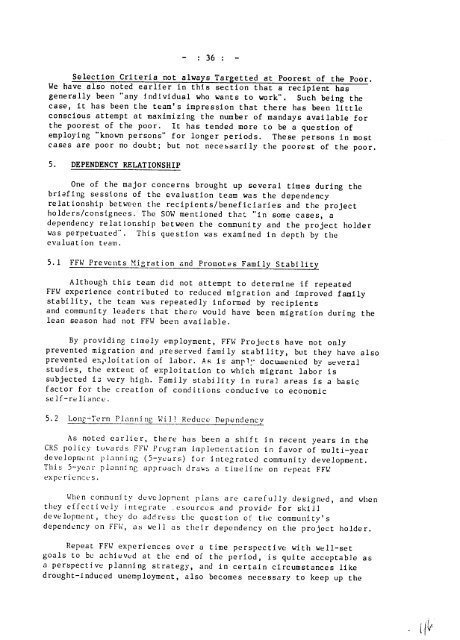(PDF, 101 mb) - USAID
(PDF, 101 mb) - USAID
(PDF, 101 mb) - USAID
Create successful ePaper yourself
Turn your PDF publications into a flip-book with our unique Google optimized e-Paper software.
- 36 -<br />
Selection Criteria not always Targetted at Poorest of the Poor.<br />
We have also noted earlier in this section that a recipient has<br />
generally been "any individual who wants to work". Such being the<br />
case, it has been the team's impression that there has been little<br />
conscious attempt at maximizing the nu<strong>mb</strong>er of mandays available for<br />
the poorest of the poor. It has tended more to be a question of<br />
employing "known persons" for longer periods. These persons in most<br />
cases are poor no doubt; but not necessarily the poorest of the poor.<br />
5. DEPENDENCY RELATIONSHIP<br />
One of the major concerns brought up several times during the<br />
briefing sessions of the evaluation team was the dependency<br />
relationship between the recipients/beneficiaries and the project<br />
holders/consignees. The SOW mentioned that "in some cases, a<br />
dependency relationship between the community and the project holder<br />
was perpetuated". This question was examined in depth by the<br />
evaluation team.<br />
5.1 FFW Prevents Migration and Promotes Family Stability<br />
Although this team did not attempt to determine if repeated<br />
FFW experience contributed to reduced migration and improved family<br />
stability, the team was repeatedly informed by recipients<br />
and community leaders that there would have been migration during the<br />
lean season had not FFW been available.<br />
By providing timely employment, FFW Projects have not only<br />
prevented migration and preserved family stability, but they have also<br />
prevented exploitation of labor. As is amply docuwenLed by several<br />
studies, the extent of exploitation to which migrant labor is<br />
subjected is very high. Family stability in rural areas is a basic<br />
factor for the creation of conditions conducive to economic<br />
self-reliance.<br />
5.2 Lonp-Term Planning Wil! Reduce Dependency<br />
As noted earlier, there has been a shift in recent years in the<br />
CRS policy towards FFW Program implementation in favor of multi-year<br />
development planning (5-years) for integrated community development.<br />
This 5-year planning approach draws a timeline on repeat FFW<br />
expe riences.<br />
When community development plans are carefully designed, and when<br />
they effectively integrate esources and provide for skill<br />
development, they do address the question of the community's<br />
dependency on FFW, as well as their dependency on the project holder.<br />
Repeat FFW experiences over a time perspective with well-set<br />
goals to be achieved at the end of the period, is quite acceptable as<br />
a perspective planning strategy, and in certain circumstances like<br />
drought-induced unemployment, also becomes necessary to keep up the

















